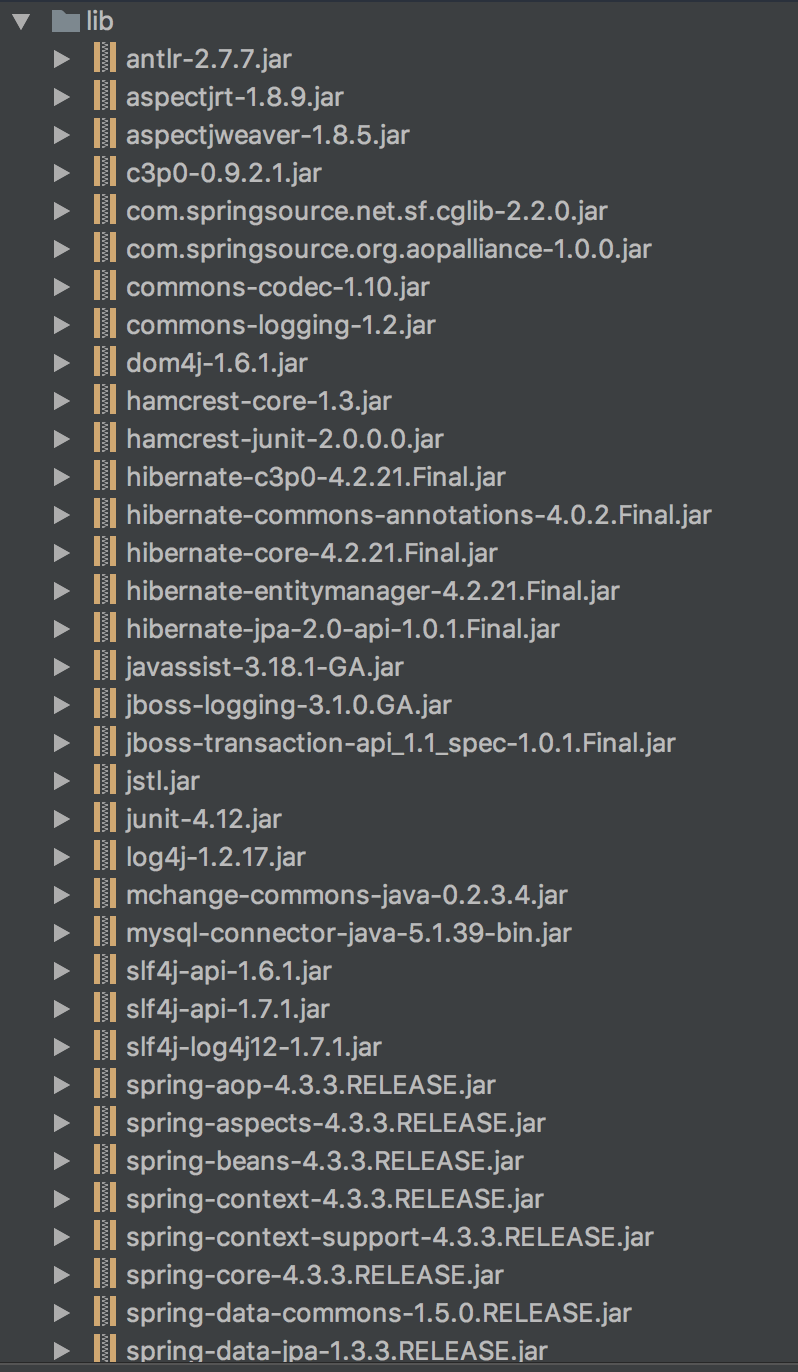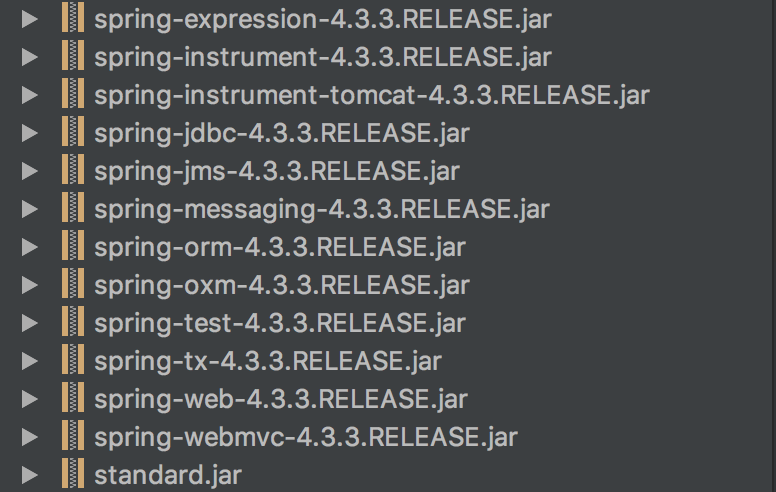1.添加依赖包:
spring和hibernate的包还是好找的,记得加入hibernate/lib/jpa里面的jar包,接着最麻烦的事jpa了,需要添加spring-data的jar包了,给个网址吧:下载spring-data
我们需要的是spring-data-commons和spring-data-jpa,记得 如果包倒入的不对的话,会出现包冲突的一场,我个人使用的是commoms-1.5.0和jpa-1.3.3,这两个是兼容的,还需要的是slf4j的jar,因为这个也是一个依赖包。附上整个项目的包结构吧:
2.配置xml
先是配置applicationContext.xml
<?xml version="1.0" encoding="UTF-8"?>
<beans xmlns="http://www.springframework.org/schema/beans"
xmlns:xsi="http://www.w3.org/2001/XMLSchema-instance"
xmlns:context="http://www.springframework.org/schema/context"
xmlns:tx="http://www.springframework.org/schema/tx"
xmlns:aop="http://www.springframework.org/schema/aop"
xmlns:jpa="http://www.springframework.org/schema/data/jpa"
xsi:schemaLocation="http://www.springframework.org/schema/beans http://www.springframework.org/schema/beans/spring-beans.xsd
http://www.springframework.org/schema/context http://www.springframework.org/schema/context/spring-context.xsd
http://www.springframework.org/schema/tx http://www.springframework.org/schema/tx/spring-tx.xsd
http://www.springframework.org/schema/aop http://www.springframework.org/schema/aop/spring-aop.xsd
http://www.springframework.org/schema/data/jpa http://www.springframework.org/schema/data/jpa/spring-jpa-1.2.xsd">
<!--自动扫描包-->
<context:component-scan base-package="cn.limbo">
<!--不要将Controller扫进来,否则aop无法使用-->
<context:exclude-filter type="annotation" expression="org.springframework.stereotype.Controller"/>
</context:component-scan>
<!--使Aspect注解起作用,自动为匹配的类生成代理对象-->
<aop:aspectj-autoproxy proxy-target-class="true"/>
<!--引入properties-->
<context:property-placeholder location="classpath:hibernate.properties"/>
<!--配置数据源-->
<bean id="dataSource" class="com.mchange.v2.c3p0.ComboPooledDataSource">
<property name="user" value="${dataSource.username}"/>
<property name="password" value="${dataSource.password}"/>
<property name="jdbcUrl" value="${dataSource.url}"/>
<property name="driverClass" value="${dataSource.driverClassName}"/>
</bean>
<!--<!–sessionFactory–>-->
<!--<bean id="sessionFactory" class="org.springframework.orm.hibernate4.LocalSessionFactoryBean">-->
<!--<!– 配置数据源属性 –>-->
<!--<property name="dataSource" ref="dataSource"/>-->
<!--<!– 配置扫描的实体包(pojo) –>-->
<!--<property name="namingStrategy">-->
<!--<bean class="org.hibernate.cfg.ImprovedNamingStrategy"/>-->
<!--</property>-->
<!--<property name="packagesToScan" value="cn.limbo.entity"/>-->
<!--<property name="hibernateProperties">-->
<!--<props>-->
<!--<prop key="hibernate.dialect">org.hibernate.dialect.MySQL5InnoDBDialect</prop>-->
<!--<prop key="hibernate.show_sql">true</prop>-->
<!--<prop key="hibernate.format_sql">true</prop>-->
<!--<prop key="hibernate.hbm2ddl.auto">update</prop>-->
<!--</props>-->
<!--</property>-->
<!--</bean>-->
<bean id="persistenceProvider"
class="org.hibernate.ejb.HibernatePersistence"/>
<bean id="jpaVendorAdapter" class="org.springframework.orm.jpa.vendor.HibernateJpaVendorAdapter">
<property name="database" value="MYSQL"/>
</bean>
<bean id="jpaDialect" class="org.springframework.orm.jpa.vendor.HibernateJpaDialect"/>
<!--jpa工厂-->
<bean id="entityManagerFactory" class="org.springframework.orm.jpa.LocalContainerEntityManagerFactoryBean">
<!--数据源-->
<property name="dataSource" ref="dataSource"/>
<!--持久层提供者-->
<property name="persistenceProvider" ref="persistenceProvider"/>
<!--适配器-->
<property name="jpaVendorAdapter" ref="jpaVendorAdapter"/>
<property name="jpaDialect" ref="jpaDialect"/>
<property name="jpaProperties">
<props>
<prop key="hibernate.dialect">${dataSource.dialect}</prop>
<prop key="hibernate.hbm2ddl.auto">${dataSource.hbm2ddl.auto}</prop>
<prop key="hibernate.show_sql">${dataSource.show_sql}</prop>
<prop key="hibernate.format_sql">${dataSource.format_sql}</prop>
</props>
</property>
<property name="packagesToScan">
<list>
<value>cn.limbo.entity</value>
</list>
</property>
</bean>
<jpa:repositories base-package="cn.limbo.dao"
entity-manager-factory-ref="entityManagerFactory"
transaction-manager-ref="transactionManager"/>
<!-- 配置Hibernate 的事物管理器 -->
<bean id="transactionManager" class="org.springframework.orm.jpa.JpaTransactionManager">
<property name="entityManagerFactory" ref="entityManagerFactory"/>
</bean>
<tx:annotation-driven transaction-manager="transactionManager"/>
</beans>
如果项目是web项目的话,一定一定要记得更改web.xml原先对sessionFactory的fliter,否则项目启动的时候会报找不到sessionFactory的错误,诶,当时有点粗心了。
web.xml
<?xml version="1.0" encoding="UTF-8"?>
<web-app xmlns="http://xmlns.jcp.org/xml/ns/javaee"
xmlns:xsi="http://www.w3.org/2001/XMLSchema-instance"
xsi:schemaLocation="http://xmlns.jcp.org/xml/ns/javaee http://xmlns.jcp.org/xml/ns/javaee/web-app_3_1.xsd"
version="3.1">
<display-name>Google Authenticator</display-name>
<welcome-file-list>
<welcome-file>login.html</welcome-file>
</welcome-file-list>
<!--配置IOC容器-->
<context-param>
<param-name>contextConfigLocation</param-name>
<param-value>classpath:applicationContext.xml</param-value>
</context-param>
<listener>
<listener-class>org.springframework.web.context.ContextLoaderListener</listener-class>
</listener>
<!--配置SpringMVC 的 DispatcherServlet-->
<servlet>
<servlet-name>springmvc</servlet-name>
<servlet-class>org.springframework.web.servlet.DispatcherServlet</servlet-class>
<init-param>
<param-name>contextConfigLocation</param-name>
<param-value>classpath:spring-mvc.xml</param-value>
</init-param>
<load-on-startup>1</load-on-startup>
</servlet>
<servlet-mapping>
<servlet-name>springmvc</servlet-name>
<url-pattern>*.do</url-pattern>
</servlet-mapping>
<!-- 配置编码方式过滤器,注意一点:要配置在所有过滤器的前面 -->
<filter>
<filter-name>characterEncodingFilter</filter-name>
<filter-class>org.springframework.web.filter.CharacterEncodingFilter</filter-class>
<init-param>
<param-name>encoding</param-name>
<param-value>UTF-8</param-value>
</init-param>
</filter>
<filter-mapping>
<filter-name>characterEncodingFilter</filter-name>
<url-pattern>*.do</url-pattern>
</filter-mapping>
<!-- 为了使用SpringMVC框架实现REST风格,需要配置 HiddenHttpMethodFilter-->
<filter>
<filter-name>hiddenHttpMethodFilter</filter-name>
<filter-class>org.springframework.web.filter.HiddenHttpMethodFilter</filter-class>
</filter>
<filter-mapping>
<filter-name>hiddenHttpMethodFilter</filter-name>
<url-pattern>*.do</url-pattern>
</filter-mapping>
<!--hibernate对对象的管理是基于session的,如果开启了延迟加载,
对于关联对象的查询可能会在渲染jsp的时候才发生,但是这个时候hibernate的当前session默认已经关闭了,
就会抛异常,所以我们经常需要hibernate在渲染jsp页面的时候还开着session,
这就需要在web.xml中配置一个拦截所有请求的filter-->
<!--如果是hibernate的话这样配置-->
<!--<filter>-->
<!--<filter-name>hibernateFilter</filter-name>-->
<!--<filter-class>org.springframework.orm.hibernate4.support.OpenSessionInViewFilter</filter-class>-->
<!--</filter>-->
<!--<filter-mapping>-->
<!--<filter-name>hibernateFilter</filter-name>-->
<!--<url-pattern>*.do</url-pattern>-->
<!--</filter-mapping>-->
<!--jpa配置的方式,需要配置entityManager-->
<filter>
<filter-name>entityManagerInViewFilter</filter-name>
<filter-class>org.springframework.orm.jpa.support.OpenEntityManagerInViewFilter</filter-class>
</filter>
<filter-mapping>
<filter-name>entityManagerInViewFilter</filter-name>
<url-pattern>*.do</url-pattern>
</filter-mapping>
</web-app>3.编写dao层
经过上面的配置之后,已经可以使用jpa了,接下来就是编写dao层的东西了
先贴上我的dao层实现
package cn.limbo.dao;
import cn.limbo.entity.User;
import org.springframework.data.jpa.repository.Modifying;
import org.springframework.data.jpa.repository.Query;
import org.springframework.data.repository.RepositoryDefinition;
import org.springframework.data.repository.query.Param;
import java.util.List;
/**
* user表的数据操作
* Created by limbo on 2016/11/26.
*/
@RepositoryDefinition(domainClass = User.class, idClass = Integer.class)
public interface UserDao{
@Query("select u from User u where u.ID = ?1")
public User getUserByID(int ID);
@Query("select u from User u where u.name = ?1")
public User getUserByName(String userName);
@Query("select u from User u")
public List<User> getAllUsers();
public void save(User user);
@Modifying
@Query("delete from User u where u.ID = ?1")
public void delete(int ID);
@Modifying
@Query("update User u set u.name = :name , u.password = :password where u.ID = :ID")
public void update(@Param("ID") Integer ID ,@Param("name") String name , @Param("password") String password);
}
实现jpa的方式有两种,一个是集成Repository<T,ID>接口,其中T表示你要操作的实体类,而ID表示实体类里面的ID的类型;还有一种就是加上注解@RepositoryDefinition
其中有两个参数一定要传值,domainClass表示实体类的Class,idClass表示ID的类型的class,就如我上面进行配置的。
jpa的接口类型有很多,一般用的最多的是
JpaRepository,还有CrudRepository,而Repository只是最基础的,没有实现任何的方法,是一个空的接口,所以可以进行自定义。
接下来就是使用dao的东西了,贴上我的service层
UserService.java
package cn.limbo.service;
import cn.limbo.entity.User;
import java.util.List;
/**
* Created by limbo on 2016/11/26.
*/
public interface UserService {
public User getUserByID(int ID);
public List<User> getAllUsers();
public void addUser(String name,String password);
public void deleteUserByID(int ID);
public void updateUser(User user);
public boolean isExist(String userName);
}
package cn.limbo.service.impl;
import cn.limbo.dao.UserDao;
import cn.limbo.entity.User;
import cn.limbo.service.UserService;
import org.springframework.beans.factory.annotation.Autowired;
import org.springframework.stereotype.Service;
import org.springframework.transaction.annotation.Transactional;
import java.util.List;
/**
* Created by limbo on 2016/11/26.
*/
@Service("userService")
@Transactional
public class UserServiceImpl implements UserService{
@Autowired
private UserDao userDao;
@Override
public User getUserByID(int ID) {
return userDao.getUserByID(ID);
}
@Override
public List<User> getAllUsers() {
return userDao.getAllUsers();
}
@Override
public void addUser(String name,String password) {
User user = new User(name,password);
userDao.save(user);
}
@Override
public void deleteUserByID(int ID) {
userDao.delete(ID);
}
@Override
public void updateUser(User user) {
userDao.update(user.getID(),user.getName(),user.getPassword());
}
@Override
public boolean isExist(String userName) {
if(userDao.getUserByName(userName) != null)
return true;
return false;
}
}
附上当时我配置的时候的参考文章
整个项目我发在了github上了,有兴趣可以看看
























 1946
1946











 被折叠的 条评论
为什么被折叠?
被折叠的 条评论
为什么被折叠?








